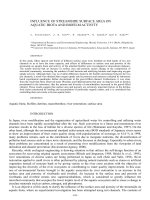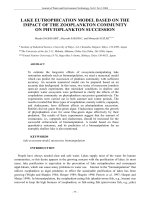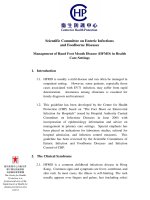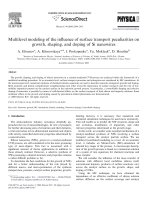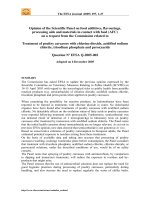opinion of the scientific committee on cosmetic products and non food
Bạn đang xem bản rút gọn của tài liệu. Xem và tải ngay bản đầy đủ của tài liệu tại đây (746.7 KB, 39 trang )
SCCNFP/0495/01, final
OPINION OF THE SCIENTIFIC COMMITTEE ON COSMETIC PRODUCTS AND NON-FOOD
PRODUCTS INTENDED FOR CONSUMERS
CONCERNING
THE SAFETY REVIEW OF THE USE OF CERTAIN AZO-DYES
IN COSMETIC PRODUCTS
adopted by the SCCNFP during the 19
th
plenary meeting
of 27 February 2002
SCCNFP/0495/01, final
Safety review of the use of certain azo-dyes in cosmetic products
_____________________________________________________________________________________________
2
1. Background
The input of the SCCNFP was requested concerning the review of the safety profile of four azo
dyes (CI 12150, CI 20170, CI 26100 and CI 27290) that are currently approved for use in
cosmetic products marketed in the EU.
The use of colorants in cosmetic products marketed in the EU is regulated through the provisions
of Annex IV of Directive 76/768/EEC, ‘List of colouring agents allowed for use in cosmetic
products’. Only those materials which are listed in this Annex can be used in cosmetic products
marketed in the EU, subject to the restrictions given in the listings.
The safety of these four azo-dyes has been questioned. The rationale for this review is on the
basis that these colorants form carcinogenic amines during metabolism. The European
Commission has been asked to revoke the positive listing of these colorants.
2. Mandate
It was requested that the SCCNFP reviewed the safety of the following azo dyes :
CI 12150, CI 20170, CI 26100 and CI 27290.
The SCCNFP was requested to give an opinion on the following questions :
* Does the safety profile of these four materials support their current positive listing under
Annex IV of the cosmetics Directive 76/768/EEC and the subsequent utilisation of the
colorants in cosmetic products under current uses and practices?
* Does the SCCNFP recommend additional restrictions on the use of these colorants in
cosmetic products?
3. Opinion on the SCCNFP
This paper will focus only on mutagenicity and carcinogenicity (SCCNFP/0474/01) of the azo-
dyes. Furthermore, this report is based on published literature.
3.1. Azo dyes
Azo compounds are by far the most widely used synthetic organic colorants. The Colour Index
lists more than 2000 azo compounds. Azo dyes are generally synthesised starting from primary
aromatic amines by diazotisation and coupling with e.g. phenols or secondary aromatic amines.
The commercial products often contain high levels of other components, especially relevant from
a toxicological point of view are aromatic amines as contaminants.
SCCNFP/0495/01, final
Safety review of the use of certain azo-dyes in cosmetic products
_____________________________________________________________________________________________
3
3.2. Mutagenicity of azo dyes
The genetic toxicology of some azo dyes has been reviewed (Combes, Haveland-Smith 1982).
Structure-activity relationships were assessed (Chung, Cerniglia 1992, Chung et al. 2000). It has
been demonstrated that sulphonated derivatives (aromatic aminosulphonic acids) generally have
no or very low genotoxic potential (Jung et al. 1992). A protocol for testing azo dyes for
mutagenic activity in Salmonella typhimurium was developed including the use of flavine
mononucleotide rather than riboflavine and hamster liver S9 for metabolic activation (Prival,
Mitchell 1982).
3.2 Carcinogenicity of azo dyes
Table 1 is a compilation of organic colorants which are recognised to be carcinogens. With the
exception of 2 compounds all these colorants are azo dyes. Furthermore, in many European
countries, e.g. in Germany, it is generally accepted that all azo dyes which may be split into
carcinogenic aromatic amines are possible carcinogens and may not be used any more in
consumer products (Technische Regeln für Gefahrstoffe, TRGS 614, Technical rules for
hazardous substances). In its opinion on the risk of cancer caused by textiles and leather goods
coloured with azo-dyes the CSTEE came to the conclusion that the concern from the point of
view of carcinogenic risk should apply to all azo dyes which have the potential to undergo in
vivo reduction to carcinogenic aromatic amines (CSTEE 1999).
3.3. Metabolism of azo dyes
The significance of azo-reduction in the mutagenesis and carcinogenesis of azo dyes is well
established. In mammals, they are metabolised to the corresponding amines following
incorporation. In the mammalian liver azo compounds are metabolised by cytosolic and
microsomal enzymes, e.g. by reductive cleavage to the amines. The intestinal microflora plays an
even more important role (e.g. Bartsch 1981, Chung 1983, Chung and Cerniglia 1992, Chung et
al. 1992, Chung et al. 2000, Levine 1991).
The reductive cleavage of azo dyes during percutanous absorption was investigated in vitro using
skin from mice, guinea pigs, and humans. All species tested were capable of reductive cleavage
of the dyes (Collier et al. 1993). Following epicutaneous treatment of rats in vivo with a
14
C-
labelled azo dye, a significant amount of radioactivity was found in urine and faeces. It was
speculated that azo cleavage resulting in the formation of aromatic amines is mediated via the
microflora of the rat skin (Aldrich 1986). Later on, it was demonstrated experimentally that
various strains of human skin bacteria split a water soluble azo dye (direct blue 14) to the
corresponding amine (o-tolidine) in vitro (Platzek et al. 1999).
SCCNFP/0495/01, final
Safety review of the use of certain azo-dyes in cosmetic products
_____________________________________________________________________________________________
4
Table 1 : List of organic colorants, recognised to be carcinogens
CI No. Name CAS No. Source
- All benzidine based azo dyes; 4,4'-
diarylazobiphenyl dyes, with the exception
of those specified elsewhere in Annex I to
Directive 67/548/EEC
- 1999/43/EC Cat 2
10385 Acid Orange 3 6373-74-6 SCCNFP/0457/01
11000 Solvent Yellow 1 60-09-3 97/56/EC Cat 2
11020 Solvent Yellow 2 60-11-7 SCCNFP/0457/01
11160 Solvent Yellow 3 97-56-3 97/56/EC Cat 2
12075
1a
Pigment Orange 5 3468-63-1 SCCNFP/0457/01
12100 Solvent Orange 2 2646-17-5 SCCNFP/0457/01
12120
2
Pigment Red 3 2425-85-6 SCCNFP/0457/01
12156 Solvent Red 80 6358-53-8 SCCNFP/0457/01
15585
1b
Pigment Red 53,
Pigment Red 53:1, barium salt
2092-56-0,
5160-02-1
SCCNFP/0457/01
16150 Acid Red 26 3761-53-3 SCCNFP/0457/01
16155 Acid Dye 3564-09-8 SCCNFP/0457/01
22120 Direct Red 28 573-58-0 1999/43/EC Cat 2
22610 Direct Blue 6 2602-46-2 1999/43/EC Cat 2
23635 Acid Red 114 6459-94-5 SCCNFP/0457/01
23850 Direct Blue 14 72-57-1 ETAD
3
23860 Direct Blue 53 314-13-6 SCCNFP/0457/01
24400 Direct Blue 15 2429-74-5 SCCNFP/0457/01
24401 Direct Blue 218 28407-37-6 SCCNFP/0457/01
30145 Direct Brown 95 16071-86-6 94/60/EC Cat 2
30235 Direct Black 38 1937-37-7 1999/43/EC Cat 2
42500
4
Basic Red 9 479-73-2 SCCNFP/0457/01
42500
4
Basic Red 9, hydrochloride 569-61-9 SCCNFP/0457/01
64500
5
Disperse Blue 1 2475-45-8 SCCNFP/0457/01
77603
6
Pigment Yellow 34 1344-37-2 SCCNFP/0457/01
77605
6
Pigment Red 104 12656-85-8 SCCNFP/0457/01
1a
Cosmetics directive Annex II No. 397 Colouring agents CI 12075 and its lakes, pigments
and salts
1b
Cosmetics directive Annex II No. 401 Colouring agent CI 15585
2
Cosmetics directive Annex IV
3
Ecological and Toxicological Association of Dyes and Organic Pigments Manufacturers
4
arylmethane
5
anthrachinone
6
97/56/EC toxic for reproduction category 1 (additional classification)
SCCNFP/0495/01, final
Safety review of the use of certain azo-dyes in cosmetic products
_____________________________________________________________________________________________
5
3.4. Metabolism, mutagenicity and carcinogenicity of aromatic amines (arylamines)
The metabolism of arylamines has been studied intensively. Ring oxidation, N-glucuronidation,
N-acetylation, and N-oxidation are the major metabolic pathways of arylamines in mammals, the
latter being the crucial step of biotoxification. The enzymes involved are cytochrom P450
(CYP1A2 and CYP3A4, respectively), yielding N-hydroxylarylamines which are further
glucuronidated in the liver or acetylated in the bladder. From these precursors in the acidic pH of
the bladder, nitrenium ions are formed which have been demonstrated to react with the DNA
base guanine. In humans there are toxicologically important individual polymorphisms of the
slow N-acetyltransferase 2 (NAT2) and of the CYP leading to differing individual
susceptibilities with regard to human bladder carcinogenesis (Marquardt et al. 1999).
The majority of the arylamines is mutagenic, especially in the Salmonella tester strains TA98
and TA100, but metabolic activation with the S9 microsomal preparation mix is required for
activity for most of the compounds.
Epidemiological studies have provided evidence for at least some aromatic amines as being
human carcinogens: benzidine and 2-naphthylamine were shown to induce urinary bladder
cancers in workers in the azo-dye industry (IARC 1975, 1982). 4-Aminobiphenyl (CAS 92-67-
1), benzidine (CAS 92-87-5) and 2-naphthylamine (91-59-8) are classified as carcinogens of
category 1 in the EU while 4-chloro-o-toluidine (CAS 95-69-2) is classified only in Germany as
category 1 carcinogen (see Table 2).
In the EU, the following amines are classified as carcinogens of category 2:
o-Aminoazotoluene (CAS 97-56-3), 4-chloroaniline (CAS 106-47-8), 4,4'-methylenedianiline
(4,4´-diamino-diphenylmethane, CAS 101-77-9), 3,3´-dichlorobenzidine (CAS 91-94-1), 3,3´-
dimethoxybenzidine (CAS 119-90-4), 3,3´-dimethylbenzidine (CAS 119-93-7), 4,4'-
methylenedi-o-toluidine (3´-dimethyl-4,4´-diaminodiphenylmethane, CAS 838-88-0), 4,4´-
methylene-bis-(2-chloroaniline) (CAS 101-14-4), o-toluidine (CAS 95-53-4), 4-methyl-m-
phenylenediamine (2,4´-toluylenediamine, CAS 95-80-7), o-anisidine (2-methoxyaniline, CAS
90-04-0), 4-aminoazobenzene (CAS 60-09-3), 4-amino-3-fluorophenol (CAS 399-95-1).
In Germany in addition the following amines are classified as carcinogens of category 2:
5-nitro-o-toluidine (2-amino-4-nitrotoluene, CAS 99-55-8), 4-methoxy-m-phenylenediamine
(2,4-diaminoanisole, CAS 615-05-4), 6-methoxy-m-toluidine (p-cresidine, CAS 120-71-8), 4,4´-
oxydianiline (CAS 101-80-4), 4,4´-thiodianiline (CAS 139-65-1), 2,4,5-trimethylaniline, (CAS
137-17-7), 6-amino-2-ethoxynaphthaline (CAS 293733-21-8). 2,4-xylidine (CAS 95-68-1) and
2,6-xylidine (2,6-dimethylaniline, CAS 87-62-7) are classified as carcinogens of category 3
corresponding to chemical law whereas in the German List of MAK and BAT Values they are
classified as carcinogens of category 2.
Recently, a draft for the risk assessment report of o-anisidine was prepared (CSTEE 2000). With
regard to carcinogenicity the authors concluded that o-anisidine was carcinogenic in rats and
mice. In both species, the main target organ is the urinary bladder. The Scientific Committee on
Toxicity, Ecotoxicity and the Environment (CSTEE) has evaluated the report. In its opinion the
committee agreed with the overall conclusion of the risk assessment (CSTEE 2001).
SCCNFP/0495/01, final
Safety review of the use of certain azo-dyes in cosmetic products
_____________________________________________________________________________________________
6
3.5. European regulations
According to the directive 1999/43/EC (17
th
amendment of directive 76/769/EEC) all benzidine
based azo dyes as well as the azo dyes Direct Red 28 (CI 22120, CAS 573-58-0), Direct Blue 6
(CI 22610, CAS 2602-46-2) and Direct Black 38 (CI 30235, CAS 1937-37-7) are classified as
carcinogens of category 2 (EEC 1999). According to the directive 97/56/EC (16
th
amendment of
directive 76/769/EEC) Solvent Yellow 1 (CI 11000, 4-aminoazobenzene, CAS 60-09-3) and
Solvent Yellow 3 (CI 11160, CAS 97-56-3) are classified as carcinogenic of category 2 (EEC
1997). Direct Brown 95 (CI 30145, CAS 16071-86-6) was classified carcinogenic of category 2
by the directive 94/60/EC (14
th
amendment of directive 76/769/EEC (EEC 1994)).
It was proposed to amend the directive 76/769/EEC with restrictions on certain azo-colorants :
Azo-dyes that may release, by reductive cleavage of one or more azo groups, one or more of the
aromatic amines listed in Appendix, in concentrations above 30 ppm in the finished articles,
according to the testing method specified in Appendix, may not be used in textile and leather
articles which have the potential of coming into direct and prolonged contact with the human
skin or oral cavity. (EEC 2000). The respective amines are listed in Table 2, Nos 1-21.
SCCNFP/0495/01, final
Safety review of the use of certain azo-dyes in cosmetic products
_____________________________________________________________________________________________
7
Table 2 : List of aromatic amines with carcinogenic potential
Number CAS-No. Name EU class
1
92-67-1 4-Aminobiphenyl CA cat 1
2
92-87-5 Benzidine CA cat 1
3
95-69-2 4-Chloro-o-toluidine CA cat 1
a
4
91-59-8 2-Naphthylamine CA cat 1
5
97-56-3 o-Aminoazotoluene CA cat 2
6
99-55-8 5-Nitro-o-toluidine (2-Amino-4-nitrotoluene) CA cat 2
a
7
106-47-8 4-Chloroaniline CA cat 2
8
615-05-4 4-Methoxy-m-phenylenediamine (2,4-
Diaminoanisole)
CA cat 2
a
9
101-77-9 4,4'-Methylenedianiline (4,4´-Diamino-
diphenylmethane)
CA cat 2
10
91-94-1 3,3´-Dichlorobenzidine CA cat 2
11
119-90-4 3,3´-Dimethoxybenzidine CA cat 2
12
119-93-7 3,3´-Dimethylbenzidine CA cat 2
13
838-88-0 4,4'-Methylenedi-o-toluidine (3´-Dimethyl-4,4´-
diaminodiphenylmethane)
CA cat 2
14
120-71-8 6-Methoxy-m-toluidine (p-Cresidine) CA cat 2
a
15
101-14-4 4,4´-Methylene-bis-(2-chloroaniline) CA cat 2
16
101-80-4 4,4´-Oxydianiline CA cat 2
a
17
139-65-1 4,4´-Thiodianiline CA cat 2
a
18
95-53-4 o-Toluidine CA cat 2
19
95-80-7 4-Methyl-m-phenylenediamine (2,4´-
Toluylenediamine, 2,4-toluenediamine)
CA cat 2
20
137-17-7 2,4,5-Trimethylaniline CA cat 2
a
21
90-04-0 o-Anisidine (2-Methoxyaniline) CA cat 2
22
60-09-3 4-Aminoazobenzene CA cat 2
23
399-95-1 4-Amino-3-fluorophenol CA cat 2
24
293733-21-8 6-Amino-2-ethoxynaphthaline CA cat 2
a
25
95-68-1 2,4-Xylidine CA cat 3
a
26
87-62-7 2,6-Xylidine (2,6-Dimethylaniline) CA cat 3
a
a
Category 2 in the German List of MAK and BAT Values
3.6. List of azo dyes based on carcinogenic arylamines (Annex 3)
Annex 3 Tables 1 – 5 gives further information on the dyes which can be split into carcinogenic
amines (source: Verband der Chemischen Industrie, Association of the German Chemical
Industry, VCI). Annex 3 Table 1 shows the azo dyes which are split into carcinogenic amines
corresponding to the German Ordinance on Commodities (Bedarfsgegenständeverordnung,
BGVO), available on the world market whereas substances listed in Table 2 of Annex 3 are not
available. Annex 3 Table 3 is a list of azo dyes which are split into carcinogenic amines not
included in the German BGVO, available on the world market whereas Annex 3 Table 4
substances are not available. Table 5 of Annex 3 is a list of azo dyes which are split into the
carcinogenic amines 2,4-xylidine or 2,6-xylidine.
SCCNFP/0495/01, final
Safety review of the use of certain azo-dyes in cosmetic products
_____________________________________________________________________________________________
8
Colouring agent CI 12150
Primary name
CI 12150
Chemical names
CI Solvent Red 1
CI Food Red 16
1-(o-Anisylazo)-2-naphthol
Sudan Rot G
1-((2-Methoxyphenyl)azo)-2-naphthol
Registry numbers
CAS : 1229-55-6
EINECS : 214-968-9
Structural formula
OH
N
N
OCH
3
Empirical formula
Emp. Formula : C
17
H
14
N
2
O
2
Mol weight : 278.3
SCCNFP/0495/01, final
Safety review of the use of certain azo-dyes in cosmetic products
_____________________________________________________________________________________________
9
Purity, composition and substance codes
There is no data available. Generally, azo dyes are known to be contaminated with the
corresponding starting materials of their synthesis, in this case o-anisidine and 2-naphthol may
be present.
Function and uses
CI 12150 is used in hair dyes (Blue List 2000). CI 12150 is listed in Annex IV Part 1 of the
cosmetics directive 76/768/EEC, with the following field of application: Column 1: Colouring
agents allowed in all cosmetic products. No other limitations and requirements are indicated.
Evaluation
Genotoxicity testing was negative in the Ames test using the "complete azo dye protocol" as
outlined by Prival and Mitchell in 1982. Negative results were also obtained with regards to the
induction of chromosome aberrations in CHO cells (Brooks et al. 1989). Using a mouse
lymphoma assay the compound was found mutagenic following exogenous activation
(Harrington-Brock et al. 1991). CI 12150 may release, by reductive cleavage of one or more azo
groups, o-anisidine which is classified as carcinogen of category 2 in the EU.
SCCNFP/0495/01, final
Safety review of the use of certain azo-dyes in cosmetic products
_____________________________________________________________________________________________
10
Colouring agent CI 20170
Primary name
CI 20170
Chemical names
CI Acid Orange 24
4-((3-((Dimethylphenyl)azo)-2,4-dihydroxyphenyl)azo)-benzolsulfonsäure, Natriumsalz
Benzenesulfonic Acid, 4-[[3-[(Dimethylphenyl)Azo]-2,4-Dihydroxyphenyl]Azo]-, Monosodium
Salt
4-[[3-[(2,4-Dimethylphenyl)Azo]-2,4-Dihydroxyphenyl]Azo]Benzenesulfonic Acid,
Monosodium Salt
4-[3-(2,4-Dimethylphenylazo)-2,4-Dihydroxyphenylazo]Benzonsulfonsäure, Natriumsalz;
D&C Brown No. 1
C-Ext. Braun 4
Resorcin Braun
Brown No. 201
Registry numbers
CAS : 1320-07-6
EINECS : 215-296-9
Structural formula
OH
OH
N NNN CH
3
CH
3
NaO
3
S
Empirical formula
Emp. Formula : C
20
H
18
N
4
O
5
S.Na
Mol weight : 448.4
Purity, composition and substance codes
There is no data available. Generally, azo dyes are known to be contaminated with the
corresponding starting materials of their synthesis, in this case resorcine, sulfanilic acid, 2,4- and
2,6-xylidine may be present.
SCCNFP/0495/01, final
Safety review of the use of certain azo-dyes in cosmetic products
_____________________________________________________________________________________________
11
Function and uses
CI 20170 is used in hair dyes (Blue List 2000). CI 20170 is listed in Annex IV Part 1 of the
cosmetics directive 76/768/EEC, with the following field of application: Column 3: Colouring
agents allowed exclusively in cosmetic products intended not to come into contact with the
mucous membranes. No other limitations and requirements are indicated.
Evaluation
CI 20170 was not mutagenic in the standard Ames test (Muzzall and Cook 1979). But no
conclusion should be drawn from the negative test result since the metabolic activation
conditions are not adequate (no Prival protocol). A chronic toxicity/carcinogenicity study
(lifetime skin painting on female mice, negative outcome) performed in 1967 by American
Cyanamid Company was cited (DFG 1991). CI 20170 may release, by reductive cleavage of one
or more azo groups, 2,4-xylidine and 2,6-xylidine which are classified as carcinogens of
category 3 corresponding to chemical law whereas in the German List of MAK and BAT Values
they are classified as carcinogens of category 2.
SCCNFP/0495/01, final
Safety review of the use of certain azo-dyes in cosmetic products
_____________________________________________________________________________________________
12
Colouring agent CI 26100
Primary name
CI 26100
Chemical names
CI Solvent Red 23
1-[(4-Benzolazo)-benzolazo]-2-naphthol
D&C Red No. 17
Sudan III
Sudan Red BK
Ölrot 3G
C-Ext. Rot 56
Benzeneazobenzeneazo-beta-naphthol
1-((4-(Phenylazo)phenyl)azo)-2-naphthalenol
1-((p-Phenylazo)phenyl)azo-2-naphthol
Registry numbers
CAS : 85-86-9
EINECS : 201-638-4
Structural formula
N N
N N
HO
Empirical formula
Emp. Formula : C
22
H
16
N
4
O
Mol weight : 352.4
Purity, composition and substance codes
There is no data available. Generally, azo dyes are known to be contaminated with the
corresponding starting materials of their synthesis, in this case purity criteria is set in the
cosmetics directive (see below Function and uses).
SCCNFP/0495/01, final
Safety review of the use of certain azo-dyes in cosmetic products
_____________________________________________________________________________________________
13
Function and uses
CI 26100 is used in hair dyes (Blue List 2000). CI 26100 is listed in Annex IV Part 1 of the
cosmetics directive 76/768/EEC, with the following field of application: Column 2: Colouring
agents allowed in all cosmetic products except those intended to be applied in the vicinity of the
eyes, in particular eye make-up and eye make-up remover. Other limitations and requirements
are indicated: Purity criteria:
aniline £ 0.2 %, 2-naphthol £ 0.2 %, 4-aminoazobenzene £ 0.1 %, 1-(phenylazo)-2-naphthol £ 3
%, 1-[2-(phenylazo) phenylazo]-2-naphthalenol £ 2 %.
Evaluation
CI 26100 was tested for mutagenicity in the Ames test. 3 out of 5 commercial samples were
mutagenic to Salmonella typhimurium strains TA98 and TA100 in the presence of S9 mix, the
purified dye, however, was not mutagenic. The mutagenic activity was assigned by the authors to
the contamination with 4-aminoazobenzene (starting material of the synthesis) (Miyagoshi et al.
1985). But no conclusion should be drawn from the negative test result since the metabolic
activation conditions are not adequate (no Prival protocol).
The clastogenic potential of CI 26100 was investigated in vitro using CHO cells without
metabolic activation. Although no metabolic activation system was added to the culture the
number of breaks per metaphase was increased following addition of CI 26100 (Au and Hsu
1979).
The carcinogenic potential of CI 26100 was investigated following oral administration via food
as a 1 % oil solution at the rate of 2 mg/animal/day to 83 male and 54 female mice. The authors
did not consider the number of lung tumours to be significantly greater than in controls, due to
the heterogeneous background of the mice. Groups of each 5 male and female Wistar rats were
fed a diet containig 40,000 mg Sudan III per kg of diet for 18 months. No tumours were
observed but no individual data on survival were given. No tumours were observed in 2 groups
of 10 female mice given repeated s.c. injections of 0.25 ml of a saturated solution of CI 26100 in
lard or about 5 mg of crystals injected subcutaneously. The working group of IARC considered
these experiments as inadequate (IARC 1975). In 2 experiments using young adult female Long-
Evans rats, CI 26100 was tested for possible carcinogenicity. In the first experimental set 0.5 ml
of a 0.5 % (wt/vol) solution in sesame oil was injected in thigh muscle of both legs of 8 rats, age
27 days. At necropsy on day 276 no tumours were present. In the second experiment a group of
16 female rats was fed by gastric instillation 1 ml of a 0.1 % (wt/vol) 5 times a week for 25
weeks. At necropsy there were no tumours found (Huggins et al. 1978). Skin painting studies in
100 (50 male/50 female) Swiss Webster mice were carried out by administering 0.1 ml of a 1 %
suspension of CI 26100 in an 1 % aqueous solution of sodium lauryl sulfate to the depilated skin
(area 6 cm
2
) once weekly for 18 months. No significant differences in body weight changes and
survival as well as tumour incidences compared to the control group were found (Carson 1984).
It is worth mentioning that CI 26100 is a strong inducer of phase I and II drug metabolizing
enzymes (mainly CYP1A and GST) which was shown to underly the protective effect against
genotoxicity of 7,12-dimethylbenzanthracene (Ito et al. 1982, Ito et al. 1984, Hatakeyama et al.
1986), benzene (Fujie et al. 1992) and benzo(a)pyrene (Fujita et al. 1988). The 7,8,12-
trimethylbenz[a]anthracene-induced leukemia in rats was prevented by combined treatment with
CI 26100 probably by the same mechanism (Huggins et al. 1978).
SCCNFP/0495/01, final
Safety review of the use of certain azo-dyes in cosmetic products
_____________________________________________________________________________________________
14
CI 26100 may release, by reductive cleavage of one or more azo groups, 4-aminoazobenzene
which is classified as carcinogen of category 2 in the EU.
SCCNFP/0495/01, final
Safety review of the use of certain azo-dyes in cosmetic products
_____________________________________________________________________________________________
15
Colouring agent CI 27290
Primary name
CI 27290
Chemical names
Sodium 6-hydroxy-5-(4-phenylazophenylazo)naphthalene-2,4-disulphonate
CI Acid Red 73
CI Solvent Red 69
D&C Red No. 13, Ext.
Baumwollscharlach extra
Brilliant Crocein MOO
7-Hydroxy-8-((4-(phenylazo)phenyl)azo)-1,3-naphthalindisulfonsäure, Dinatriumsalz
1,3-Naphthalenedisulfonic Acid, 7-Hydrooxy-8-[[4-(Phenylazo)Phenyl]Azo]-, Disodium Salt
Registry numbers
CAS : 5413-75-2
EINECS : 226-502-1
Structural formula
N
N
N
N
HO
SO
3
Na
SO
3
Na
SCCNFP/0495/01, final
Safety review of the use of certain azo-dyes in cosmetic products
_____________________________________________________________________________________________
16
Empirical formula
Emp. Formula : C
22
H
16
N
4
O
7
S
2
.2Na
Purity, composition and substance codes
There is no data available. Generally, azo dyes are known to be contaminated with the
corresponding starting materials of their synthesis, in this case 4-aminoazobenzene and 7-
hydroxy-1,3-naphthalinesulfonic acid may be present.
Function and uses
CI 27290 is used in hair dyes (Blue List 2000). CI 27290 is listed in Annex IV Part 1 of the
cosmetics directive 76/768/EEC, with the following field of application: Column 4: Colouring
agents allowed exclusively in cosmetic products intended to come into contact only briefly with
the skin. In a footnote it is mentioned that the insoluble barium, strontium and zirconium lakes,
salts and pigments of this colouring agent shall also be permitted. They must pass the test for
insolubility which will be determined by the procedure laid down in Article 8. No other
limitations and requirements are indicated.
Evaluation
CI 27290 may release, by reductive cleavage of one or more azo groups, 4-aminoazobenzene
which is classified as carcinogen of category 2 in the EU.
SCCNFP/0495/01, final
Safety review of the use of certain azo-dyes in cosmetic products
_____________________________________________________________________________________________
17
3.7. Conclusion
The azo dyes CI 12150, CI 20170, CI 26100, and CI 27290 are expected to be cleaved into the
carcinogenic amines o-anisidine (CI 12150), 2,4- and 2,6-xylidine (CI 20170), and 4-
aminoazobenzene (CI 26100 and CI 27290). Following application onto the skin this might take
place on the surface of the skin mediated by skin bacteria, during percutaneous absorption within
the skin, and systemically in the liver but there is no data available. Furthermore, there is no data
available on the amount of percutaneous absorption of the mentioned dyes. The published data
on genotoxicity is incomplete and does not rule out a genotoxic potential of the dyes.
Carcinogenicity was investigated only with CI 26100 but the studies were inadequate. Purity
criteria exist only for CI 26100 (Annex IV of the cosmetics directive). Generally, azo dyes are
known to be contaminated with the respective starting materials, in the case of CI 1250, CI
20170 and CI 27290 o-anisidine, 2,4- and 2,6-xylidine, and 4-aminoazobenzene may be present,
respectively, which are known carcinogens (see Table 2). Considering the scarce data on purity,
toxicology and exposure no risk assessment can be performed for the mentioned dyes. But, from
the available literature on the chemical class of azo dyes it can be deduced that all azo dyes
which are split into carcinogenic arylamines are possible carcinogens.
3.8. Opinion
The SCCNFP is of the opinion that based on the available information the use of the colorants CI
12150, CI 20170, CI 27290, CI 26100 and of other azo dyes which may release one or more
carcinogenic aromatic amines, poses a risk to the health of the consumer.
3.9 References
1. Aldrich FD. (1986) Excretion of radioactivity from rats and rabbits following cutaneous
application of two
14
C-labeled azo dyes. J Toxicol Environ Health 18: 347-355.
2. Au W, Hsu TC. (1979) Studies on the clastogenic effects of biologic stains and dyes.
Environ Mutagen 1: 27-35.
3. Bartsch H. (1981) Metabolic activation of aromatic amines and azo dyes. IARC Sci Publ
40: 13-30.
4. Blue List. (2000) Cosmetic Ingredients. Kemper FH, Luepke N-P, Umbach W (eds), Editio
Cantor Verlag, Aulendorf
5. Brooks AL, Seiler FA, Hanson RL, Henderson RF. (1989) In vitro genotoxicity of dyes
present in colored smoke munitions. Environ Mol Mutagen 13: 304-313.
6. Carson S (1984) Skin painting studies in mice on 11 FD&C and D&C colors: FD&C
Green No. 3, Red No. 2, Red No. 4, Yellow No. 6, and External D&C No. 7, D&C Orange
No. 4, Violet No. 2, Red No. 17, Red No. 34, and yellow No. 7. J Toxicol Cut Ocul
Toxicol 3: 309-331.
7. Chung K-T. (1983) The significance of azo-reduction in the mutagenesis and
carcinogenesis of azo dyes. Mutat Res 114: 269-281.
8. Chung K-T, Cerniglia CE. (1992) Mutagenicity of azo dyes: structure-activity
relationships. Mutat Res 277: 201-220.
9. Chung K-T, Stevens SE, Cerniglia CE (1992) The reduction of azo dyes by the intestinal
microflora. Crit Rev Microbiol 18: 175-190
SCCNFP/0495/01, final
Safety review of the use of certain azo-dyes in cosmetic products
_____________________________________________________________________________________________
18
10. Chung K-T, Chen S-C, Wong TY, Li Y-S, Wei C-I, Chou MW. (2000) Mutagenicity
studies of benzidine and its analogs: Structure-activity relationships. Toxicol Sci 56:351-
356.
11. Collier SW, Storm JE, Bronaugh RL. (1993) Reduction of azo dyes during in vitro
percutaneous absorption.Toxicol Appl Pharmacol 118: 73-79.
12. Combes RD, Haveland-Smith RB. (1982) A review of the genotoxicity of food, drug and
cosmetic colours and other azo, triphenylmethane and xanthene dyes. Mutat Res 98: 101-
248.
13. CSTEE. (1999) Opinion on risk of cancer caused by textiles and leather goods coloured
with azo-dyes. Opinion expressed at the 7
th
CSTEE plenary meeting.
14. CSTEE. (2000) Risk assessment of o-anisidine. Draft of 19.4.2000. Doc. CSTEE/2000/17.
15. CSTEE. (2001) Opinion on the results of the risk assessment of o-anisidine. Opinion
expressed at the 21
st
CSTEE plenary meeting.
16. DFG. (1991) Kosmetische Färbemittel. Farbstoffkommission der Deutschen
Forschungsgemeinschaft. VCH, Weinheim.
17. EEC. (1994) Directive 94/60/EC of the European Parliament and of the Council of 20
December 1994 amending for the 14
th
time of Directive 76/769/EEC on the approximation
of the laws, regulations and administrative provisions of the Member States relating to
restrictions on the marketing and use of certain dangerous substances and preparations.
Official Journal of the European Communities L 365 1-9.
18. EEC. (1997) Directive 97/56/EC of the European Parliament and of the Council of 20
October 1992 amending for the 16
th
time Directive 76/769/EEC on the approximation of
the laws, regulations and administrative provisions of the Member States relating to
restrictions on the marketing and use of certain dangerous substances and preparations.
Official Journal of the European Communities L 333 1-84.
19. EEC. (1999) Directive 1999/43/EC of the European Parliament and of the Council of 25
May 1999 amending for the 17
th
time Directive 76/769/EEC on the approximation of the
laws, regulations and administrative provisions of the Member States relating to
restrictions on the marketing and use of certain dangerous substances and preparations.
Official Journal of the European Communities L 166 87-90.
20. EEC. (2000) Amended proposal for a directive of the European Parliament and of the
council amending for the 19
th
time Council Directive 76/769/EEC relating to restrictions
on the marketing and use of certain dangerous substances and preparations (azocolourants)
(presented by the Commission pusuant to Article 250 (2) of the EC Treaty). COM(32000)
785 final.
21. EEC. (2001) Amended proposal 2001/C 96 E/18 for a Directive of the European
Parliament and of the Council amending for the nineteenth time Council Directive
76/769/EEC relating to restrictions on the marketing and use of certain dangerous
substances and preparations (azocolourants)(
1
). Official Journal of the European
Communities C 96 E, 269-271.
22. Fujie K, Ito Y, Maeda S. (1992) Acute cytogenetic effect of benzene on rat bone marrow
cells in vivo and the effect of inducers or inhibitors of drug-metabolizing enzymes. Mutat
Res 298: 81-90.
23. Fujita S, Matsunaga T, Masubishi Y, Suzuki T. (1988) Possible mechanism of Sudan III-
induced prevention of chemical carcinogenesis in rats. Cancer Res 48: 254-259.
24. Harrington-Brock LP, Parker L, Doerr C, Cimino MC, Moore M. (1991) Analysis of the
genotoxicity of anthraquinone dyes in the mouse lymphoma assay. Mutagenesis 6: 35-46.
25. Hatakeyama S, Hayasaki Y, Masuda M, Kazusaka A, Fujita S. (1996) Mechanism for
mouse strain differences in the protective effect of Sudan III against the in vivo
genotoxicity of 7,12-dimethylbenz[a]anthracene. Toxicol Lett 89: 231-239.
SCCNFP/0495/01, final
Safety review of the use of certain azo-dyes in cosmetic products
_____________________________________________________________________________________________
19
26. Huggins CB, Ueda N, Russo A. (1978) Azo dyes prevent hydrocarbon-induced leukemia
in the rat. Proc Nat Acad Sci 9: 4524-4527.
27. IARC. (1975) Monographs on the evaluation of the carcinogenic risk of chemicals to man.
Vol. 8: Some aromatic azo compounds. Lyon, France.
28. IARC. (1982) Monographs on the evaluation of the carcinogenic risk of chemicals to man.
Vol. 29: Some industrial chemicals and dyestuffs. Lyon, France.
29. Ito Y, Maeda S, Fujihara T, Ueda N, Sugiyama T. (1982) Suppression of 7,12-
dimethylbenz(a)anthracene-induced chromosome aberrations in rat bone marrow cells after
treatment with Sudan III and related azo dyes. J Nat Cancer Inst 69: 1343-46
30. Ito Y, Maeda S, Souno K, Ueda N, Sugiyama T. (1984) Induction of hepatic gluthatione
transferase and suppression of 7,12-dimethylbenz(a)anthracene-induced chromosome
aberrations in rat bone marrow cells by Sudan III and related azo dyes. J Nat Cancer Inst
73: 177-183.
31. Jung R, Steinle D, Anliker R. (1992) A compilation of genotoxicity and carcinogenicity
data on aromatic aminosulphonic acids. Food Chem Toxicol 30: 635-660.
32. Levine WG. (1991) Metabolism of azo dyes: implication for detoxication and
activation. Drug Metab Rev 23: 253-309.
33. Marquardt H, Schäfer SG, McClellan RO, Welsch F. (1999) Toxicology. Academic Press,
San Diego.
34. Miyagoshi M, Hayakawa Y, Nagata M, Nagayama T. (1985) Mutagenic activities of
commercial Sudan III and Scarlet Red are due to impurities. Eisei Kagaku 31: 79-86.
35. Muzzall JM, Cook WL. (1979) Mutagenicity test of dyes used in cosmetics with the
Salmonella/mammalian-microsome test. Mutat Res 67: 1-8.
36. Platzek T, Lang C, Grohmann G, Gi U-S, and Baltes W. (1999) Formation of a
carcinogenic aromatic amine from an azo dye by human skin bacteria in vitro. Human
Experimental Toxicology 18: 552-559.
37. Platzek T, Stahlmann R, Riecke K, Lang C, Höcker C. (2001) Textilfarbstoffe -
Regulation und experimentelle Studien: Ein Beitrag zu Exposition, Metabolismus und
Allergien. Bundesgesundheitsblatt 44: 695-704
38. Prival MJ, Mitchell VD. (1982) Analysis of a method for testing azo dyes for mutagenic
activity in salmonella typhimurium in the presence of flavin mononucleotide and hamster
liver S9. Mutat Res 97: 103-116.
39. SCCNFP. (2001) Opinion concerning chemical ingredients in cosmetic products classified
as carcinogenic, mutagenic or toxic to reproduction according to the chemicals directive
67/548/EEC. Opinion expressed at the 18
th
plenary meeting.
SCCNFP/0495/01, final
Safety review of the use of certain azo-dyes in cosmetic products
_____________________________________________________________________________________________
20
Annex 1
Basic data on the amines 4-aminoazobenzene, o-anisidine, 2,4-xylidine, and 2,6-xylidine
4-Aminoazobenzene
Primary name
4-Aminoazobenzene
Chemical names
CI Solvent Yellow 1
CI 11000
p-Aminoazobenzene
4-(Phenylazo) benzenamine
Registry numbers
CAS : 60-09-3
EINECS : 200-453-6
Structural formula
N N
NH
2
Empirical formula
Emp. Formula : C
12
H
11
N
3
Mol weight : 197.2
Evaluation
4-Aminoazobenzene is classified as carcinogen of category 2 in the EU.
SCCNFP/0495/01, final
Safety review of the use of certain azo-dyes in cosmetic products
_____________________________________________________________________________________________
21
o-Anisidine
Primary name
o-Anisidine
Chemical names
1-Amino-2-methoxy-benzene
2-Methoxyaniline
2-Aminoanisole
Registry numbers
CAS : 90-04-0
EINECS : 201-963-1
Structural formula
NH
2
OCH
3
Empirical formula
Emp. Formula : C
7
H
9
NO
Mol weight : 123.16
Evaluation
o-Anisidine is classified as carcinogen of category 2 in the EU.
SCCNFP/0495/01, final
Safety review of the use of certain azo-dyes in cosmetic products
_____________________________________________________________________________________________
22
2,4-Xylidine
Primary name
2,4-Xylidine
Chemical names
m-Xylidine
2,4-Dimethylaniline
1-Amino-2,4-dimethylbenzene
4-Amino-1,3-dimethylbenzene
2-Methyl-p-toluidine
2,4-Dimethylbenzenamine
2,4-Dimethylphenylamine
Registry numbers
CAS : 95-68-1
EINECS : 202-440-0
Structural formula
CH
3
NH
2
CH
3
Empirical formula
Emp. Formula : C
8
H
11
N
Mol weight : 121.18
Evaluation
2,4-Xylidine is classified as carcinogen of category 2 in Germany.
SCCNFP/0495/01, final
Safety review of the use of certain azo-dyes in cosmetic products
_____________________________________________________________________________________________
23
2,6-Xylidine
Primary name
2,6-Xylidine
Chemical names
2,6-Dimethylaniline
2,6-Dimethylbenzenamine
o-Xylidine
1-Amino-2,6-dimethylbenzene
2-Amino-1,3-dimethylbenzene
2-Amino-m-xylene
2-Amino-1,3-xylene
2,6-Xylylamine
Registry numbers
CAS : 87-62-7
EINECS : 201-758-7
Structural formula
H
3
C
CH
3
NH
2
Empirical formula
Emp. Formula : C
8
H
11
N
Mol weight : 121.18
Evaluation
2,6-Xylidine is classified as carcinogen of category 2 in Germany.
SCCNFP/0495/01, final
Safety review of the use of certain azo-dyes in cosmetic products
_____________________________________________________________________________________________
24
Annex 2
Aromatic amines and colouring agents in Annex II of the directive 76/768/EEC
No. 22 Aniline, its salts and its halogenated and sulphonated derivatives (see Dossier
Table 2 No. 7)
No. 26 Benzidine (see Dossier Table 2 No. 2)
No. 32 Toluidines, their isomers, salts and halogenated and sulphonated derivatives (see
Dossier Table 2 No. 3 and 18)
No. 33 Xylidines, their isomers, salts and halogenated and sulphonated derivativesa
No. 81 4-Phenylazophenylene-1,3-diamine citrate hydrochloride (chrysoidine citrate
hydrochloride) (not in Dossier Table 2)
No. 242 1- and 2-Naphthylamines and their salts (see Dossier Table 2 No. 4)
No. 363 o-Phenylenediamine and its salts (not in Dossier Table 2)
No. 364 4-Methyl-m-phenylenediamine (see Dossier Table 2 No. 19)
No. 376 1-Methoxy-2,4-diaminobenzene (2,4-Diaminoanisole - CI 76050) and their salts (see
4-Methoxy-m-phenylenediamine Dossier Table 2 No. 8)
No. 377 1-Methoxy-2,5-diaminobenzene (2,5-diaminoanisole) and their salts (not in Dossier
Table 2)
No. 378 Colouring agent CI 12140 (derived from amine 2,4-xylidine see Dossier Table 2 No.
25)
No. 379 Colouring agent CI 26105 (derived from amine o-toluidine see Dossier Table 2 No.
18)
No. 380 Colouring agent CI 42551, CI 42551-1, CI 42551-2 (not an azo dye, arylmethane)
No. 383 2-Amino-4-nitrophenol (not in Dossier Table 2)
No. 384 2-Amino-5-nitrophenol (not in Dossier Table 2)
No. 386 Colouring agent CI 42640 (not an azo dye, arylmethane)
No. 387 Colouring agent CI 13065 (azo dye, amine not in Dossier Table 2)
No. 388 Colouring agent CI 42535 (not an azo dye, arylmethane)
No. 389 Colouring agent CI 61554 (not an azo dye, anthraquinone)
No. 397 Colouring agents CI 12075 and its lakes, pigments and salts (amine 2,4-dinitroaniline
not in Dossier Table 2)
No. 398 Colouring agent CI 45170 and CI 45170:1 (not an azo dye, xanthene)
No. 401 Colouring agent CI 15585 (amine not in Dossier Table 2)
No. 406 4-Ethoxy-m-phenylenediamine and its salts (not in Dossier Table 2)
No. 412 4-Amino-2-nitrophenol (not in Dossier Table 2)
No. 413 2-Methyl-m-phenylenediamine (not in Dossier Table 2)
SCCNFP/0495/01, final
Safety review of the use of certain azo-dyes in cosmetic products
_____________________________________________________________________________________________
25
Annex 3
Table 1 : Azo dyes which are split into carcinogenic amines corresponding to the German
Bedarfsgegenständeverordnung, available on the world market
No. C.I No. Name / Synonym Diazocomponent
1 - Acid Black 29 Benzidine
2 - Acid Black 209 3,3'-Dimethylbenzidine (o-Tolidine)
3 30 334 Acid Black 232 Benzidine
4 30 336 Acid Black 94 Benzidine
5 22 195 Acid Orange 45 Benzidine
6 26 420 Acid Red 104 o-Aminoazotoluene, o-Toluidine
7 23 635 Acid Red 114 3,3'-Dimethylbenzidine (o-Tolidine)
8 27 200 Acid Red 115 o-Aminoazotoluene, o-Toluidine
9 - Acid Red 119:1 p-Chloroaniline
10 24 125 Acid Red 128 3,3'-Dimethoxybenzidine (o-Dianisidine)
11 26 665 Acid Red 148 o-Aminoazotoluene, o-Toluidine
12 20 530 Acid Red 158 o-Toluidine
13 - Acid Red 167 3,3'-Dimethylbenzidine (o-Tolidine)
14 16 140 Acid Red 24 o-Toluidine
15 18 129 Acid Red 265 o-Toluidine
16 18 065 Acid Red 35 o-Toluidine
17 22 245 Acid Red 85 Benzidine
18 37 085 Azoic Diazo Component 11 4-Chloro-o-toluidine
19 37 105 Azoic Diazo Component 12 2-Amino-4-nitrotoluene
20 37 235 Azoic Diazo Component 48 3,3'-Dimethoxybenzidine (o-Dianisidine)
21 37 225 Azoic Diazo Component 112 Benzidine
22 - Azoic Diazo Component 113 3,3'-Dimethylbenzidine (o-Tolidine)
23 21 010 Basic Brown 4 2,4-Toluylendiamine
24 - Basic Yellow 103 4,4'-Diaminodiphenylmethane
25 76 035 Developer 14
= Oxidation Base 20
2,4-Toluylendiamine
26 - Direct Black 154 3,3'-Dimethylbenzidine (o-Tolidine)
27 22 580 Direct Black 29 Benzidine
28 30 235 Direct Black 38 Benzidine
29 30 245 Direct Black 4 Benzidine
30 24 410 Direct Blue 1 3,3'-Dimethoxybenzidine (o-Dianisidine)
31 22 590 Direct Blue 2 Benzidine
32 23 705 Direct Blue 3 3,3'-Dimethylbenzidine (o-Tolidine)
33 22 610 Direct Blue 6 Benzidine
34 24 140 Direct Blue 8 3,3'-Dimethoxybenzidine (o-Dianisidine)
35 24 155 Direct Blue 9 3,3'-Dimethoxybenzidine (o-Dianisidine)
36 24 340 Direct Blue 10 3,3'-Dimethoxybenzidine (o-Dianisidine)
37 23 850 Direct Blue 14 3,3'-Dimethylbenzidine (o-Tolidine)
38 24 400 Direct Blue 15 3,3'-Dimethoxybenzidine (o-Dianisidine)
